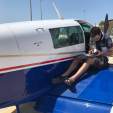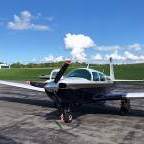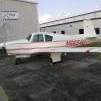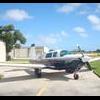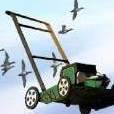Leaderboard
Popular Content
Showing content with the highest reputation on 01/18/2021 in all areas
-
I've been getting a lot of requests for an update on this Mother of all Annuals... But in my mind, there really isn't much to say about it other than it's still in progress... But I'm there are details that might help someone else contemplating this work or with it coming up, ready or not. I should get a couple of disclaimers out of the way first. This is a hobby, not a business and therefore time is NOT money. So I've opted for the slower/cheaper option over the faster/expensive path whenever possible. I keep an eye towards what increases the value of my Mooney and what doesn't. JD got the engine boxed up ready for shipment to Jewell very quickly, but didn't ship it until David was ready to get started on it. So it ended up going to Jewell the second week of December. And then there is the holiday season... It was disappointing to wait so long, but all the engine shops were backed up and running behind. And Jewell was no different. The faster/expensive option here would have been to buy an engine months ago and have it waiting when the annual started in September. I decided not to do that obviously. So here we are at the middle of January. All the engine components have checked out and the rebuilding is under way. I'll be keeping the case, crank, and cylinders. The turbo, waste gate, fuel pump, and governor, have all checked out, but are out for overhaul and should be done this week. JD thinks he'll have the engine back in his shop by the end of this month. Other work that has been going on in the mean time at SWTA: Vacuum speed brakes changed out for electric brakes - done Larger dual puck wheel brakes installed with doors and other components - done Counter weights for Encore weight increase, installed. Wingtips modified to accommodate new weights. - in progress Glareshield - with Hector at AeroComfort for re-covering JPI EDM-900 - remapped with Encore limits - done Minor leak in left fuel tank - patched Panel mounted compass - in progress Annual - will be completed after engine is reinstalled Fingers crossed, I'll be in Texas flying and breaking in the engine sometime in Feb. And we'll fly it to Mexico for a week on the beach in March.7 points
-
A lot of the discussion above centers around how to avoid reloading the approach, when you get a late clearance change you weren't expecting. The commonly-discussed case is when you thought you were getting vectors to final, then you get cleared to an IAF or IF instead. Hence the "Never load VTF" strategy to avoid that particular case. I have a contrarian position about this. I teach students to practice reloading approaches to select a different transition, until they can do it quickly and correctly with little anxiety or stress. Then the guidance on loading approaches becomes simply, "Load your best guess at a transition/VTF, change as needed". Using myself and my own airplane as an example, I don't consider it some kind of workload crisis if I've loaded one transition (VTF or otherwise), and then get cleared to a fix not in my flight plan. The HOME -> PROC -> Approach -> Transition -> Activate sequence on a GTN navigator is pretty ingrained, so just a few seconds and no big deal to change the plan. If I'm being cleared to an IF rather than an IAF, then the extra steps are HOME -> Flight Plan -> select fix -> Activate Leg. It's a little more involved on an "etch-a-sketch" GNS navigator, but I teach in some airplanes with those, and I still don't think it's too bad: reload with PROC -> big knob to Select Approach -> Enter -> Enter -> Big knob to select transition -> Enter -> Enter. If being cleared to an IF instead of an IAF, add FPL -> big knob to select fix -> Direct -> Enter -> Enter. My main problem with the "Always load this, never load that" strategy, is it primes the student to think switching to a different transition is somehow "scary" and/or an unfair request by ATC. That doesn't bode well for fairly common situations that require deft button-ology even without ever loading VTF. e.g. training/proficiency flights with multiple approaches in compressed time and space, and/or ATC reroutes to a different IAF/IF late in the sequence for legitimate operational reasons. I have a lot less instruction given than Mark, Gary Reeves, etc. You should weight their opinions more than mine. But I think it's fair to say that "Never load VTF" doesn't guarantee you'll never have to reload an approach late in the game. So just like you're expected to be able to hand-fly an approach without an autopilot, fly partial panel if an instrument fails, etc; so should you also be reasonably proficient at reloading approaches to select a different transition. As Don says above, it's just not that hard to change on-the-fly (literally in this case ).7 points
-
This post serves to post the 2018 Mooney Fatal Accidents so we can learn and discuss prevention methods in an effort to lower future fatal accidents for our community. I'll break down the info as best I can, and I will highlight possible causes if they are not identified by the NTSB. In 2018, there were seven fatal accidents resulting in 9 fatalities. 02/2018 - CFIT (final report) - The pilot's failure to maintain clearance from terrain during a visual approach in dark night visual meteorological conditions, which resulted in controlled flight into terrain. 03/2018 - Loss of aircraft control (final report) - The pilot's exceedance of the airplane's critical angle of attack during takeoff, which resulted in an aerodynamic stall/spin. Report speculates that a possible factor was the pilot's seat slide back. There is not enough evidence to support that claim but it is something that has caused Mooney crashes. 04/2018 - Loss of aircraft control (final report) - The pilot's failure to maintain adequate airspeed while departing in instrument meteorological conditions, moderate turbulence, and low-level wind shear, which resulted in the airplane exceeding its critical angle of attack and a subsequent aerodynamic stall. *My take: this could have also been spatial disorientation which drove loss of aircraft control. 08/01/2018 - Loss of aircraft control (final report) - Loss of aircraft control in the final turn. The pilot's exceedance of the airplane's critical angle of attack while maneuvering for landing, which resulted in a cross-control aerodynamic stall, spin, and impact with terrain. Contributing to the accident was the flight instructor's delayed remedial action in preventing the stall. 08/11/2018 - Loss of aircraft control (final report) - Loss of aircraft control in the final turn. The pilot's exceedance of the airplane's critical angle of attack during the landing approach as a result of his diversion of attention after a series of non-essential aircraft systems became inoperative following the failure of the engine-driven vacuum pump, which resulted in an aerodynamic stall/spin. 09/2018 - Loss of aircraft control (final report) - The pilot’s failure to maintain aircraft control during a go-around due to his premature flap retraction, which resulted in an aerodynamic stall and subsequent loss of control. 11/2018 - Collision with terrain (final Report) - for reasons that could not be determined based on the available information. Contributing to the accident was the pilot's poor preflight planning and poor decision to depart on the accident flight. Recommendations/takeaways for us: 1. For 2018, Loss of aircraft control accounts for 71% of Mooney fatalities. This is statistically significant and much higher than 2017. 2. Task management and misprioritization of a non-critical system malfunction are contributing factors in two of these accidents. Systems knowledge and a good scan of available instrument data can help pilots correctly identify the malfunction and categorize it as a "land as soon as possible" vs "land as soon as practical." For us at Mooneyspace, when is the last time you read the POH and reviewed critical systems such as your electric, fuel, and vacuum setup? If you can't remember, please set aside some time to study. 3. For those of us who are CFI/CFII, the 08/01/18 crash should serve as a reminder to know when a student/pilot has exceeded their limits and take aircraft control prior to exceeding yours. Everyone has techniques, but for those who are new CFIs, realize be conservative in your approach. Sometimes, pilot error can put the plane in such a position that there is no time for a verbal correction, and a physical intervention is required to maintain a flying attitude. 4. 2018 saw a 42% higher accident rate compared to 2017 Mooney fatal accidents. Also of note, none of the fatal accidents in 2018 were related to catastrophic mechanical failure such as engine or structural failure. Lack of proficiency, lack of currency, and a breakdown in instrument crosscheck led to loss of situational awareness for almost all of these accidents. For those who fly regularly for travel, set aside some time to practice approaches and landings, or practice instrument approaches. For those have large breaks in flying, spend the time with a CFI and focus on tasks you are rusty or weak at and build your proficiency and confidence. These are just my observations and thoughts on how to help our community analyze accidents and how to incorporate what we learn into our safety culture.4 points
-
It does. "Reloading from scratch" is only needed if you have deleted them or never loaded them to begin with. Exactly the point. On a T approach, coming in from the NoPT sector, I will ask for and probably get direct to the IF. I'm naturally lazy, so far more efficient for me to load the logical T on my side and go direct to the IF when instructed than to change the transition if due to traffic, ATC needs to send me to the T. Yes, of course ATC can send me to the "wrong" T so ultimately it's only a 90/10% guess. Yeah, I know I tend to rant about this. In addition to being lazy, I also fly and teach in different aircraft with different avionics packages, so a consistent working methodology has value. I find it also helps transitioning pilots by keeping familiar things familiar and focusing on the truly different. it's not only VTF which does that. I know people who "clean up" the flight plan by deleting waypoints before the one they are going to. But that's more of a STAR thing than an IAP thing. BTW, I do not use my preference to violate my First Commandment of instructing - "Thou shalt not change a technique which works s just because you like another better." Yes, I may well set up a scenario where I think it would be a better technique to load an IAF rather than VTF, but if they hand it well I won't try to force a change.4 points
-
The Bravo seems to be the most under valued airframe in the fleet for some time now. It doesn't make sense IMO. Sent from my iPhone using Tapatalk4 points
-
4 points
-
Let's try again, then. I'll usually ask for the approach I want, and am either told to "Expect it" or given another approach to "Expect". If I don't like what I''m told to "Expect", I push nicely for what I want. Usually I get what I want. Once I know the approach I'll be doing, I'll 'Load" it. I usually ask for the "Full" approach because it shortens the final and has all legs as a part of it. If I'm given vectors, the whole approach is still there and when I see where the final vector will intercept the final approach course, I'll activate that leg. When I'm in the approach waypoints "box" (my term) the approach is active, no "Activate approach" menu item necessary. If I'm in the enroute phase of flight and told to proceed "Direct to" my IAF. I have a choice. The choices are identical, only with different names. I can highlight the IAF and hit the "direct to" button, or I can push "Activate the Approach" icon. Both take me directly to the IAF and, since the waypoint is inside the approach "box" the approach is active. Basically the "Activate approach" icon is a shortcut to the IAF to begin the approach. I usually just go "Direct to" the IAF and skip the "Activate approach" icon, since they both do the same thing.3 points
-
Virtually all AP troubleshooting is done without running the engine. That's why its so important to seek out a AP specialist with the test harness Jake mentions above in order to efficiently troubleshoot the system. The test harness gear fits between each of the servos being tested and allow simulating AP functions and measuring response to isolate a failure. When it can't be repeated on the ground it may well require a test flight to try to duplicate it, but like anything else intermittent issues are the hardest to troubleshoot. Also, the pilot too can do a lot to trouble shoot the AP performing all the preflight actions without the engine running but using the electric standby vacuum and testing both heading left/right, pitch up/down with trim and AP disconnect.3 points
-
As Garmin mentioned in the initial release of the Xi, with the extra processor speed new opportunities would open up for more advanced features. This first software update added some new features not available on the legacy GTN. Another one is the addition of the glide range ring with an arrow stream pointing to the best choice of "gliding to" runways. Of course, Garmin Pilot already has that, but not the "arrow stream to the best airport for gliding to.3 points
-
The new GTN Xi software update makes things even easier. Garmin brought back a shortcut bar like the knob on the GNS that cycled from NAV- Waypoint-Aux-NRST, so from any page you can quickly take a shortcut to another page. So, for example, say you're on the MAP page and want to load an approach. Instead of a number of Taps to get to the Procedures Page, you'd just twist the knob a couple of turns and you're on the Procedures Page. You can set up a number of shortcuts that best suit your flying needs.3 points
-
Not sure if everyone is aware, but no need to hit HOME to get the Flight Plan on the GTN. Instead, tap the active leg line ABOVE the CDI (circled in red below) on the map or default nav page to open the flight plan. You can also load and activate an approach from the flight plan page if you want although hitting HOME then PROC is pretty quick. Personally, I like using minimum steps cycling between Map and Default Nav page and Back and tapping the CDI on the GTN for the flight plan during flight. I also load my expected approach and use activate legs, Direct to IAP Fix or AVTF depending on the situation. If you’re activating the IAP within 2-3 miles of the FAF, you’re probably a little behind the airplane.3 points
-
Although the 252 is a superior plane, and I wish I had waited for one rather than buying a 231, the 231 is still a good plane, and if operated carefully, it will do the job. I don't fly very high every much, but the ability to easily get up to 14 to 17K, over most of the weather and a lot of the traffic is nice.3 points
-
3 points
-
Garmin has created a a perennial source of confusion with the term ACTIVATE. Activating an approach simply means: Fly present position direct to the first waypoint (IAF) on the currently loaded approach procedure and resume auto-sequencing. This is almost never what you want to do. But there is a general misconception that somehow you must always “activate” an approach to fly it, and so I’ve seen some use the Activate function when they really don’t need to. In reality, you can make any waypoint or leg (outside of the FAF) of the loaded approach procedure active and the GPS will auto-sequence through the approach. Skip3 points
-
Wastegate, Controllers, and turbocharger overhaul approximately 5K. Double that for an Acclaim with twin turbos. From my experience these need to be done mid-engine time. For the airplane cost difference and the extra engine maintenance I have heard on the Acclaim, for a little less speed, the Bravos are the bargains out there now in my opinion.3 points
-
I think the thing to remember in the Garmin Universe is that the enroute flight plan waypoints and the approach waypoints can be considered to be in 2 separate boxes with the approach box AFTER the enroute box. If you are flying waypoints in the enroute box and have a dual waypoint in the approach box, you'll won't transition to the approach box when you cross that waypoint in the enroute box unless it's the last waypoint in that box. You will need to cross all waypoints in the enroute box first, then automatically proceed to the approach box. That is usually undesirable. An approach gets activated by going directly to any waypoint in the approach box. There are 3 ways to activate an approach: 1. Cross all the waypoints in the enroute box and then automatically go to the first waypoint in the approach box (Undesireable usually because you would go to the airport first and then back out to an IAF). 2. Select "Activate the approach" in the menu which sends you directly to the first waypoint in the approach box. 3. Highlight the first waypoint in the approach box, and press the Direct To button. As part of 3, you could also select ANY waypoint in the approach box and the approach is activated. Again activating an approach just means you are operating in the approach box. BTW, Loading an approach just means you are inserting the approach box into the overall flight plan after the enroute box with no activation.3 points
-
While I have no bravo time, I have a large amount of ovation and acclaim time. To say that they are basically the same plane below 10,000’ just is not accurate. They can be flown at near identical numbers if the acclaim is babied, and the 310hp ovation will absolutely outclimb the acclaim maybe to 2000’, but they are even at that point with the acclaim steadily pulling away. I also disagree that a turbo is useless below 12k. At 12k the ovation may squeak out 21” while the acclaim can produce 33”, or 30.5 at max cruise. This means better climb, and more speed. The acclaim can also be flown almost identical to an ovations fuel numbers, only burning slightly more at LOP or ROP, but having much more speed and climb available at any moment. The turbo is not necessary of course, but aviation is all about trade offs, and once you become accustomed to a turbo, you have a very hard time going back. Lastly, I have not found the maintenance to be a great deal more in the three that I have owned, and aside from more frequent oil changes, is well worth the expense. I know the bravo is not as fast as the acclaim, but would think it’s more like the acclaim than not. If speed is irrelevant, you ever won’t go anywhere near weather, and don’t live near mountains, you may never wish you had a turbo, but no matter what your mission, if you flew one for 100 hours and had to go back to NA, chances are you would be disappointed. Point being, a turbo provides options and advantages unavailable to a NA plane and anytime the airframes are the same and a turbo is the distinguishing difference, the turbo will outperform the NA in nearly every aspect. Almost all the people I have spoken to about turbos who rag on them have never owned one, and just gave second hand anecdotal hangar talk. Talk to someone who owns and knows how to fly a turbo, and you will hear the straight dope. They almost all love them!3 points
-
I'm still having trouble understanding this comment. Were you trying to sit with your feet flat on the floor? You sit in a Mooney with your feet straight out, knees straight, with only your heals touching the floor. The seat is so close to the floor I can't possibly imagine how your knees/thighs were anywhere near the yoke or the bottom of the panel unless you were bending your knees and pulling them up. That sitting position definitely won't work. We get this "Will I fit?" question all the time, but usually it's asked by the wrong people. If you are tall, good news... you fit! It's the short people who don't ask and really should be asking. If your legs are too short, you won't have room for the yoke with your feet on the pedals. If your back isn't long enough, you won't see over the panel. Both can be fixed with rudder pedal extensions and seat cushions. But to be too tall, you'd really need to be about 6' 9" or taller.3 points
-
The Encore conversion on N252AD is in progress and hope to be completed and flying in a few more weeks. When I first signed on to MooneySpace years ago, @Parker_Woodruff was talking about his Encore conversion... it's been a long road, but I'm excited to be so close to owning an Encore myself... finally.3 points
-
The reason I posted is If you have a plug don't remove the assembly to clean the grease from the bearings....there is none.2 points
-
Thanks for posting this, and for the effort that went into it. It's always good to be reminded that training and proficiency are critical factors in the successful outcome of a flight, and we should be careful not to focus too much on things that are relatively unlikely to kill us.2 points
-
Fly Direct-to WPT or Activate Leg should work in all boxes in the same way: simple FPL sequencing (except in hold/missed/OBS mode where one suspends) In theory, no point VTF or load/activate (apart from checking distances/tracks against plates), one could just fly Direct-to IF/IAF or intercept an (IAF,FAF) active leg when requested by ATC, the rest would just flow naturally... PS: starting all from scratch with 3 fresh clicks is way easier than understanding what the hell went wrong in my last 20 clicks, also quick "3 clicks in 10s" is a usefull skill to have with busy ATC: things raraly go as planned even if your FPL page was properly setup before takeoff2 points
-
Believe it or not I’ve found that the modern IPhone is pretty capable of measuring the plane tilt at the avionics bay seam, and it’s even more capable of laying against the panel face to measure its angle. Delta between the two is the panel tilt.2 points
-
Find an Bendix King autopilot specialist with the necessary BK test harness. Without this gear and expertise you can spend a fortune repairing things in the system that doesn't fix the issue. But since it's failing the start up test with less beeps a BK AP specialist should be able to figure it out pretty quick. But not a typical A&P. Sent from my iPhone using Tapatalk2 points
-
I am the proud owner of a 231. It is a wonderful airplane - but I would not buy one with a GB engine without the necessary upgrades. Mine has the LB engine and the intercooler, waste gate, GAMI, etc. upgrades. It runs relatively cool, and has great climb performance. The turbo is definitely a plus. Still, even in this configuration, I would expect mid-time cylinder and turbo replacements, which mine had done before I bought it. What I don't particularly like is the fact, that takeoff is not with full throttle, which takes time to get used to. Sent from my iPhone using Tapatalk2 points
-
Well, I have no direct experience with the GB. My aircraft has the LB plus intercooler and Merlyn wastegate. What I can tell you comes from watching the engine operate on a JPI 930. I don’t think the nonintercooled, fixed wastegate GB would be a very good choice. honestly. The GB had a reputation for running hot. With the fixed wastegate and no intercooler I think you would find it difficult to get much above 15,000. Its a combination of things. That is the critical altitude for the non Merlyn engine (maybe 15,500, but it varies depending on the day). The CA is much higher in my aircraft, about 22,500. I have been above it a few times, and the problem is that the climb rate becomes very anemic, probably 300 fpm or less. In addition, when you get up in the higher altitudes the thinner air does not cool anything very well. The Compressor Discharge Temp. redline on that engine is 280, and on most days you probably would hit that at around 17k. The engine would be struggling above the CA and probably overheating. I know the POH has book numbers up into the Flight Levels, but realistically I think you would find its not easy to get up that high with that combination. The LB with the intercooler and Merlyn wastegate is a much better option, The LB has inherently better cooling, the intercooler reduces the Induction Air Temperature about 100 dF, and the wastegate lets you get up quite a bit higher. If you don’t want to pay the cost for that combination, then the 201 might be about as good a choice as the GB engined 231. My .02.2 points
-
2 points
-
VTF versus the full approach from an IAF or IF: You can't go wrong ever loading the full approach and I always used to teach always to load the full approach and then activate the leg you are being vectored onto - without exception. This is still the only way to fly a NPA IMO. But VTF works just fine on any PA where you know you are being vectored on to final. Why? We almost never care about intermediate fixes on a PA when we know we'll be instructed to intercept final approach coarse and told to maintain a final altitude till established - in which case we don't care about those intermediate waypoints and their altitudes - we're following the GS for vertical guidance. There are of course exceptions, such as some of the long ILS with lot's of step downs, such as coming into LAX with mandatory altitudes not associated with the glideslope. So if not familiar, stick with the always safe and sure approach of loading the full approach with the nearest IF transition, then re-activate the correct leg for where you are being vectored onto the approach. But the GTN's even made VTF more powerful by adding the waypoints on final outside of the FAF. Although with VTF loaded, when you activate the approach, it will still show the coarse guidance only to FAF, the waypoints outside of the FAF on the final are still loaded right behind the FAF. So if the controller at the last minute clears you direct to one of these waypoint or tell you to intercept one of these legs then you need only to bring up the flight plan page by touching the CDI on GTN map page and then touch the waypoint to either go direct or to activate that leg in front of that waypoint. You no longer need to re-load the full approach to get those waypoints back! Bruce's charts didn't discuss the finer points of VTF with the GTN's so I suggest if you aren't aware of this to study it more on the GTN simulator because VTF just got a lot more powerful on the GTN's and VTF's is what teach for flying any PA when you know you are being vectored onto final. And with the GTN it still works out fine if you get a last second surprise with an earlier waypoint or leg on final before the FAF.2 points
-
It has both mask and oxysaver ranges and the mechanism is easier to adjust precisely throughout the full range. What every Turbo pilot needs. NA pilots may not appreciate it as much. Sent from my iPhone using Tapatalk2 points
-
Part 43 App A part c(21) says you can replace any hose end except hydraulic. Arguing will probably commence from there, whether or not it is OPP, etc.. Whatever your IA says is the opinion that matters, since he'll approve or not at your annual anyway.2 points
-
You need to see "Magenta inside the approach" on the Flight Plan page -- If for example your Flight plan page looks like this JUGMO KMTN RNAV GPS 33 Approach JUGMO CINDI RWY33 and you are headed to the first JUGMO intersection in that list, no, the approach won't activate or sequence (at least not until after first proceeding to KMTN, then back to JUGMO). If instead your flight plan page looks like this JUGMO KMTN RNAV GPS 33 Approach JUGMO CINDI RWY33 where the active next waypoint is the second JUGMO ("inside the approach") then yes, the GTN750 will sequence to the RNAV approach. {Unless of course you fly east of the cone of confusion on an odd-numbered day, in which case the back course localizer will be active}2 points
-
Clarence if you ever get bored you should write a book, "maintaining your mooney". I would buy the first copy. I have been working on mooneys for a long time and you still bring up new stuff I have not seen before. Mark2 points
-
Well, we left N252AD in Smithville, TX in the capable hands of JD and Laura Casteel at SWTA. It's time for the big one. Her engine made it to 1830 hours on the original cylinders and turbo. But she's definitely tired. Only one cylinder was able to make compression over about 50. And her belly is just one long oil slick all the way to the tail skid. The governor is leaking oil as well, and the vacuum pump can't seem to muster enough power to deploy the speed brakes anymore. This year's annual will include an engine overhaul and Encore conversion. The engine, turbo, waste gate, governor, and fuel pump will all go to Jewell Aviation for overhaul and conversion from an MB to an SB engine. All of the other Encore parts are laid out and organized by Laura, ready for installation. This includes new double puck brakes and all the associated parts and pieces. New control surface counter weights, instrument remapping, and the engine stuff. We will also swap the vacuum speed brakes for electric and remove the remainder of the vacuum system. And finally swap the dangling compass for a panel mounted version. We're looking forward to a horse power increase and useful load in the 1100 lb range when it's all said and done. To say nothing of a clean belly. A big thanks to @Denver98 for picking us up in Smithville and giving us a ride back to Denver in a Cessna 421. A very nice ride.1 point
-
While I strongly believe, that over time, the market is always what determines the price. I do believe however that the market values the Bravo where it is because it's "misunderstood". The engine will cost about $20,000 more for a factory rebuilt than for a factory rebuilt for an Ovation ($65,000 vs $45,000, R & R labor should be close to the same). However if you do a lot of cross country travel in the teens, conservatively, you should have at least a 20 knot advantage, meaning that for every hour on the Bravo engine time you've traveled an additional 20 nautical miles. So you are traveling more miles between overhauls which cuts down some of the cost per mile over time. Also if you manage the temperatures well, there's a strong chance you can go to TBO with the Lycoming Bravo cylinders. It's almost a given that the Continental cylinders will need to be overhauled or replaced at around half TBO. So the operating cost difference in real life is much less than what people would think. People will also say you don't need a turbo if you live here or there, but having the turbo gives you many options no matter where you live since you still have excellent climb performance as far up as the service ceiling will take you. In the summer you can quickly get over a lot of the buildups in the mid afternoon for a smoother ride. In the winter, flying eastbound, you can get up to an altitude where you have near-turboprop ground speeds (I've seen 300 kts groundspeed a few times up at FL250 in the winter.). Even flying into a headwind, if you need to do it in the lower teens for weather, is a lot more tolerable with the TAS advantage of the Bravo. So are they "undervalued"? The market is what the market is, but for a serious prospect who does their homework and doesn't just go off of conjecture I think they are a good value comparatively. I can't think of more speed for the dollar in certified airplanes.1 point
-
It looks exactly like the issue I had with mine. Long story short - the cause was the bearing on the trim torque tube below the trim servo. It seldom sees some lube during annuals, gets stuck and produces what you are experiencing.1 point
-
My LASIK reached its end of life four years ago after a 14 year run. While my Rx isn't all that bad and my lenses are wafer thin, I was disappointed that it didn't last longer. Nothing is forever.1 point
-
My LASIK finally reached the end of its life when my cataracts became bad enough to warrant surgery. Had one eye done in February, and then the COVID shutdown hit. It was July before the right was done. The left is set for slightly longer distance than the right, and my pea-brain has adapted well to the difference. Have not tried them out flying at night, but just the improvement in driving at night was remarkable. The decrease in light and color degradation was so slow, it was surprising the difference. During the months I only had one done, I would amuse myself by noticing differences in what I thought a color was in my right (OEM) eye and the left (upgraded). Vision for the left is 20/15 and the right is 20/20, so I am happy with the results. For the first time since I was 13, I do not wear any prescription glasses.1 point
-
Thanks Vance! I see that now if I read the 327 install manual. I also checked every pin on this harness to better understand what is going on and it also appears as if they wired the G5s for a 430W and have the connector for VOR/ILS info wired up. *le sigh* Now I am wondering I I should try and get rid of the 400W and pick up a 430W and replace my old Terra 760Ds at the same time...*double sigh* It appears as if I would only need to add 7 wires to the harness to go to a GMA 340. (which also means replacing my com panel and intercom...should have known this would not be this easy!) And carusoam, thanks! (but also no!) All the easy questions I figured out just be reading the forums1 point
-
Don't know what happened, but that's why they tell you to brake in a straight line--energy decreases to the square of speed, so if you waste any tire grip trying to swerve and fail, you're hosed (aside from the possibility of losing control). Spending all your tire grip on straight line braking is less risky to your health.1 point
-
"Appropriate" is a judgment. It includes all procedure waypoints along the extended final approach course.1 point
-
The reason why there are so many questions and only some answers on this topic is that it was not designed by professional pilots. They do not even ask pro pilots how they can make it better so as to be totally intuitive. I have had my GTN650 now for about three years and I still cant tell you exactly how I should program it. I have the trainer to try things out but its a drag.... I still dont know how to fly a star that hooks directly up to an RNAV approach. Will I have to activate the approach at some point or will it fly it? Who knows... On a real box whatever leg is in the FLT PLN page the box will fly. You cant say that about the GTN.....1 point
-
The M20K elevator has a downspring which is why the elevator hangs down to the stop when the airplane is on the ground. The trim primarily changes the angle of incidence of the tail and to a lesser extent adjusts the tension on the downspring to improve longitudinal stability. On M20J and earlier models with trim bungees, the trim would move the yoke quite a bit on the ground. I've never tried it on a M20K, but since it is always a downspring, I would expect that the yoke would not move (but just be held nose down with a varying force) as the trim is moved from full up to full down. You can check this easily by simply moving the trim wheel from stop to stop. This has nothing to do with the autopilot operation. Engaging the autopilot on the ground can be confusing because the autopilot is a closed loop system and without the airplane responding to servo commands, the feedback loop is broken. For instance, say the airplane isn't exactly level and the attitude indicator shows a 1/2 degree right bank. The autopilot will command left aileron. But, sitting on the ground, the airplane will not bank. So, the autopilot will command more left aileron. The airplane still cannot respond. This continues until eventually the ailerons will be fully deflected to the left. Skip1 point
-
Very important... have you seen the letter writing campaign..? Find @Baker Avionics. Greg has a request in a thread around here... It is to support getting the Mooney / Dynon AP closer to the front of the line... at Dynon... This may be helpful as we wait for TT to get organized... Best regards, -a-1 point
-
Ken, not everyone has bought a few dozen planes like you, many in fact are buying their first plane and benefit from professional advice and counseling throughout the buying process. A good percentage of the pre-buys we work result in recommending the client find another. Our fee is $750, but many only pay half that. We start with a review of the logs, which is free. If we continue we review the sales agreement providing input when needed, help find a shop for the pre-buys and provide a pre-buys checklist. Our checklist is broken up into phases so if a major discrepancy is found we stop there to avoid unnecessary shop fees. The buyer pays the shop fees to the shop. We then coach the buyer through the final negotiations. For a lot of inexperienced buyers, we more than save them the cost of our fee and reduce a lot of the risk. Much more info on SavvyAviation.com Sent from my iPhone using Tapatalk1 point
-
I flew my Mooney from Florida to Don Maxwell for the rigging. It was a very good experience. He first flew the plane himself, adjusted with his team everything with the Mooney travel boards ... and then flew it again. He was very fast on that because he must have done it thousand times or so. Sure, your local mechanic would be able to do it too. But first he has to borrow the travel boards somewhere and if he had not done it before, it make take 3 times longer and not get you any improvement.1 point
-
My experience with 3 Mooney paint processes with Artcraft, no rigging was performed. Only balance check of newly painted control surfaces. Control surfaces were unbolted only and removed for painting. No control attachment points were touched, adjusted or moved. Intetesting though.1 point
-
This happens by forgetting to raise the flaps after takeoff . . . A situation usually found while wondering why cruise speed is so low.1 point
-
I have a 63C. I made the pilot panel the same angle as the copilot panel which is technically to much of an angle for the G5, however I have a Aspen and a G5 and have had no problems with them. Your big problem will be the Stec. I would also take the shock mount out of what you have.1 point
-
There's a member here who is 6'9", but I don't recall what year his F is . . . . @Yetti So no, you aren't too big, but remember, a Mooney isn't a Suburban and won't have that mind of space.1 point


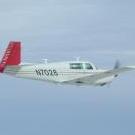


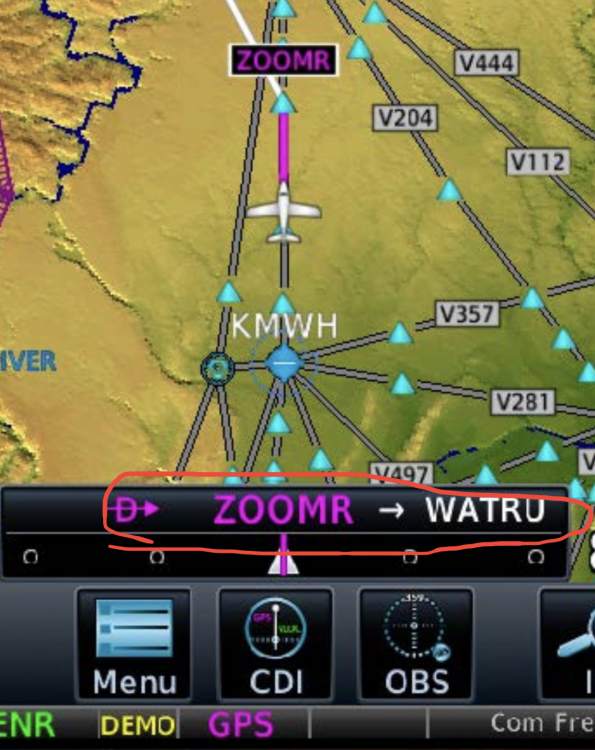
.thumb.png.7c67574d7b28f67b0b4a17760919b1ac.png)


